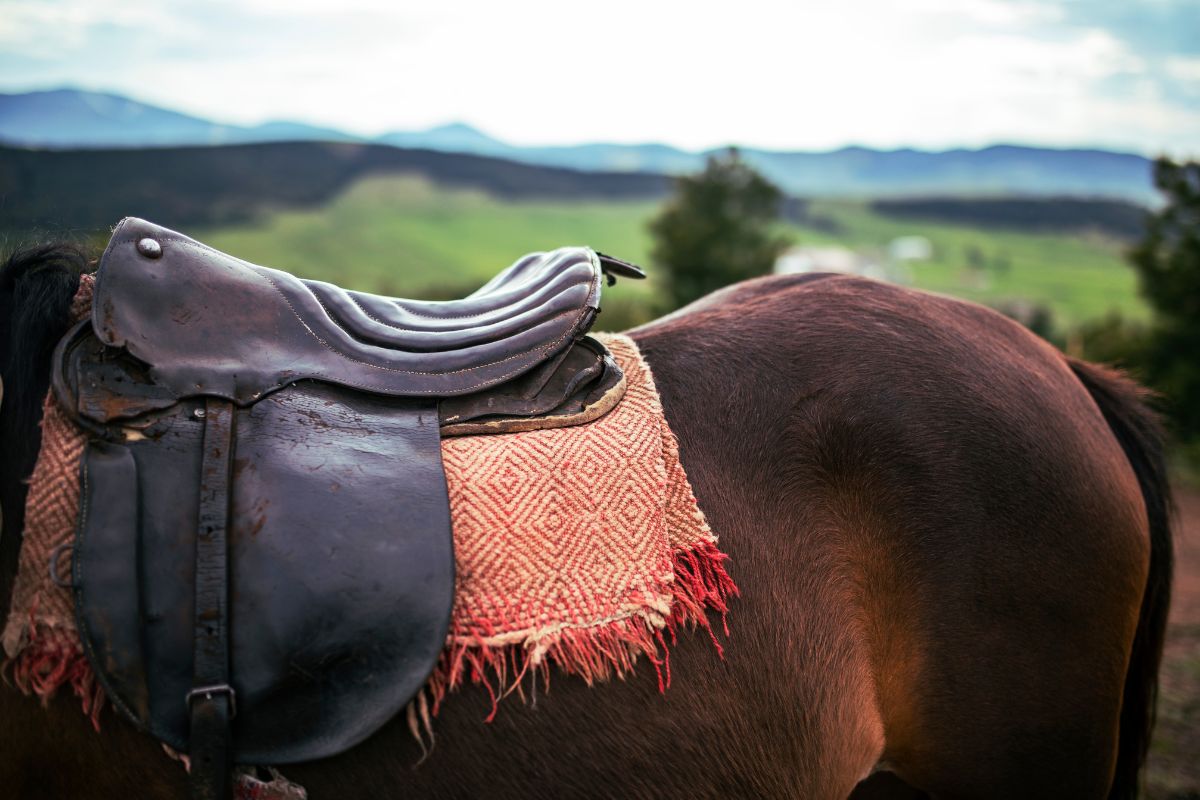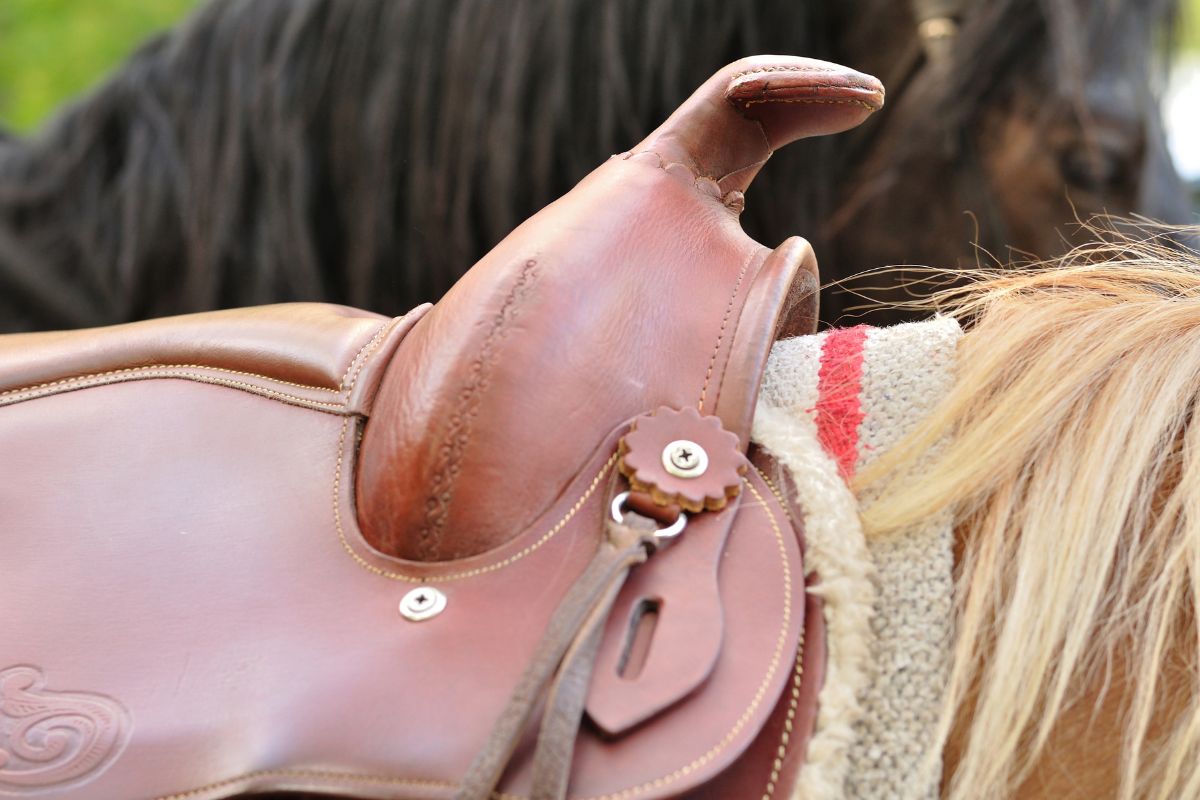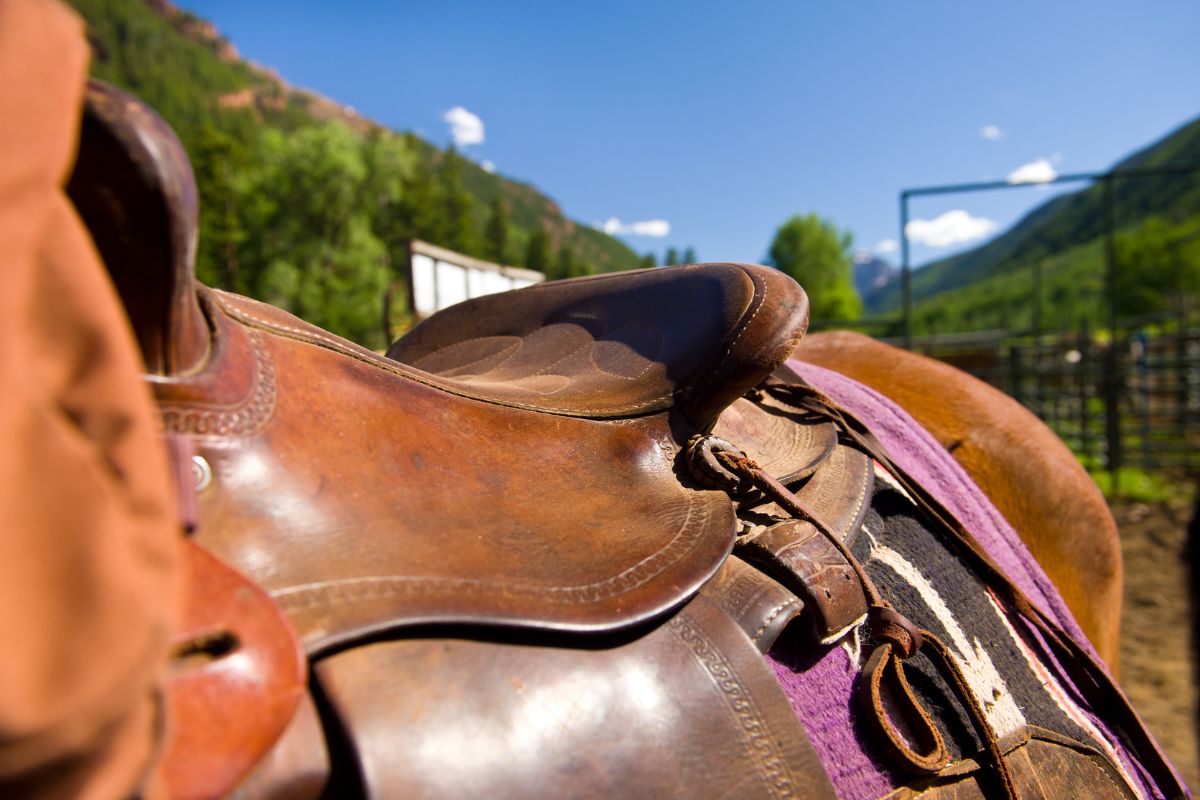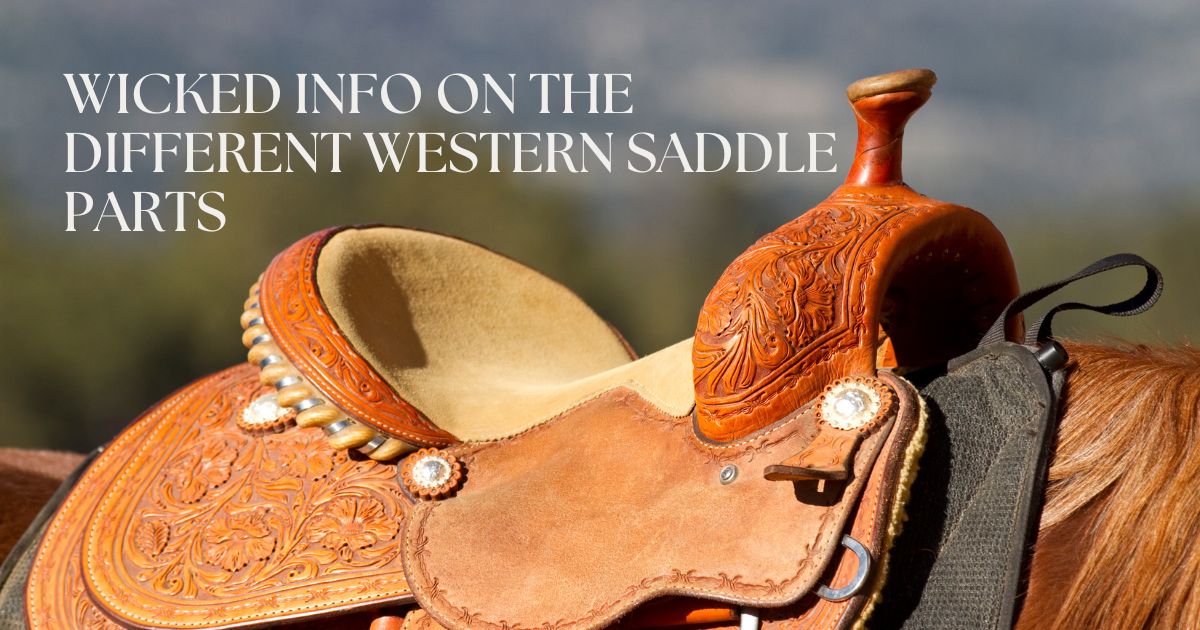Are you interested in learning about western saddle parts? You’ve come to the right place!
A western saddle has many parts that serve a specific purpose. If you’re curious to learn more about what each piece does, or if you’re looking for advice on how to care for your saddle, you’ve come to the right place.
Keep reading to learn more!

The Western Saddle for Equines
The western saddle is a type of saddle designed to be comfortable for both the rider and the horse. Unlike other types of saddles, western saddles have a variety of different parts that all serve a specific purpose.
While western saddles are most commonly associated with cowboys and the American West, they are used all over the world for a variety of different riding disciplines.
Types of Western Saddles
Here are the ten types of western saddles:
- Trail saddles
- Roping saddles
- Show saddles
- Mounted shooting saddles
- Ranch saddles
- Ranch cutting saddles
- Reining Saddles
- Cutting saddles
- Allround saddles
- Barrel saddles
Naming the Different Western Saddle Parts
The anatomy of a saddle has many different parts that all serve a specific purpose.
Below are the various western saddle parts’ names.
Back billet/flank billet: The strap starts from the back of the saddle and goes down the horse’s sides to where it attaches to the cinch.
Back cinch/flank cinch: The back cinch is a strap that goes underneath the horse at the back of the saddle. It is attached to the saddle with the back billets. The back cinch prevents the saddle from moving around on the horse’s back, creating a more secure and comfortable ride during activities such as roping or riding on uneven terrain.
Breast collar: Although a breast collar is not technically part of a saddle, it frequently uses one. The breast collar is attached to the front of the saddle in various ways and locations. Its primary purpose is to keep the saddle from sliding too far back; however, in some instances, it can also prevent a tipping or overturned saddle.
Cantle: The cantle is the back of the saddle. It helps to support the rider’s weight and keeps the rider from sliding off the back of the saddle.
Front cinch: The front cinch goes beneath the horse’s stomach, in front of the saddle. On the right side of the saddle (the “offside”), there is a strap called a billet or off billet that attaches it to the saddle. The left side has the latigo, which connects it to the other half of said straps on alternate sides.
Horn: The horn, also called the “saddle horn,” is likely the most well-known component of a Western saddle. Its primary function is to secure one end of a rope while the other end loops around an animal, such as a cow or calf.
Saddle horns have numerous purposes: they support mounting or dismounting, can hold pommel saddle bags, and more.
Latigo: The front cinch secures the horse by this strap, which is often made from leather but can also be nylon.
Latigo keeper: This tab, with a horizontal slit, holds the excess length of the latigo on a saddled horse.
Maker’s mark: A maker’s mark is an identifying stamp used by a saddle maker to identify their saddles. The common places to find a maker’s mark include stirrup fender, latigo keeper, and stirrup hobble. A maker can choose to place their stamp in any number of locations.
Pommel/fork/swells/: The pommel is the front of the saddle. It acts as a handle for the rider and helps balance the rider’s weight.
Seat jockey/back jockey: The jockeys, or “housings,” are designed to protect the saddles from wear and tear. Some saddles, such as those used for barrel racing, do not have a back jockey to reduce weight.
Skirt: The “saddle skirt,” referred to as a “skirt,” connects to the saddle tree and hangs down the horse’s side. The bottom part of the skirt on the inside has a lining of sheepskin material, which can be real or imitation. It helps keep the rider’s legs tangled in the stirrups.
Stirrups: Stirrups are the loops of leather or metal in which the rider puts their feet. They help to keep the rider in the saddle and provide a place for the rider to rest their feet.
Stirrup fender: The stirrup fender attaches to the saddle at the top and holds the stirrup at the bottom. This helps keep your foot in place while riding and prevents mud and debris from getting inside the stirrup.
Stirrup Hobble: This strap goes around the bottom of the stirrup fender, just above the stirrup. The stirrup hobble may appear to be a nonessential saddle component. Still, it serves an essential purpose: It prevents the stirrup from leaving its correct position at the bottom of the stirrup fender and traveling up the length of the fender.
The tree: The tree is the part of the saddle that provides support and structure. Its material is typically wood or synthetic.
Each of these western saddle parts’ identification is important for the proper function of the western saddle. If one of these parts is damaged or missing, it can cause severe problems while riding. That’s why it’s important to know how to identify and care for each part of your saddle.
How to Measure Your Horse for a Western Saddle
To ensure a proper fit, you’ll need to take some measurements of your horse. You’ll need a helper, as it can be challenging to get accurate measurements while holding the measuring tape yourself.
1. Start by measuring from the center of the horse’s chest, just behind the elbows, to the point of the hip. This is the horse’s “girth,” and you’ll use this measurement to determine the size of the saddle’s tree.
2. Next, measure from the point of the shoulder to the point of the buttock. This is the horse’s “back length” and will be used to determine the size of the saddle’s seat.3. Finally, measure the horse’s width at the widest point of the hindquarters. This is the horse’s “flank” and will be used to determine the size of the skirt.
Once you have these measurements, you can use them to select a saddle that is the right size for your horse. If you’re unsure which size to choose, it’s always best to err on the side of too big rather than too small.

The History of Western Horse Saddles
The western saddle is a uniquely American invention and has a long and rich history. The first western saddles were designed in the late 1800s based on the design of the Spanish Vaquero saddle. These early saddles were simple and functional, and they were perfect for the needs of the time.
As the United States’ westward expansion progressed, the need for a more comfortable and versatile saddle became apparent. In response, saddlemakers began to experiment with new designs and materials.
One of the most important innovations was the inclusion of a horn on the front of the saddle. This allowed riders to control their horses and made it possible to tie things to the saddle.
Another important innovation was the introduction of stirrups. Stirrups allowed riders to stay in the saddle and made it possible to ride for extended periods without getting tired.
As the western saddle evolved, it became increasingly popular with riders of all kinds. Today, it is one of the world’s most popular types of saddles, and riders of all disciplines use it.
Which Western Horse Saddle Parts are Replaceable?
Most western saddles can last many years, but you will eventually need to replace some parts. Here are some of the most common elements of a western saddle that you can replace:
The saddle tree is the most essential part of the saddle, and it is also the most expensive. If your saddle tree shows signs of wear, it is vital to have it replaced as soon as possible.
You will eventually need to replace the leather on a western saddle. This is because the leather will dry out and crack over time. When this happens, it is essential to have the saddle re-leathered by a qualified saddlemaker.
At some point, you will also need to replace the stirrups. This is because the metal can break down over time, and the leather can dry out and crack. When this happens, it is important to have the stirrups replaced by a qualified saddlemaker.
You can also replace the girth because the leather can dry out and crack over time.
By replacing these parts as needed, you can help to ensure that your saddle will last for many years.
How Long Do Western Equine Saddles Last on Average?
Assuming that you take proper care of it, a western saddle can last many years. The average lifespan of a well-made saddle is around 25 years, but some saddles can last much longer.
Of course, the lifespan of a saddle will vary depending on how often you use it and how well you care for it. If you use your saddle regularly, it is vital to have it inspected and serviced by a qualified saddlemaker every few years.
Taking proper care of your saddle can help ensure that it will provide years of comfortable riding.
Our Tips for Extending the Saddle’s Lifespan
If you want your saddle to last for as long as possible, there are a few things you can do:
- Store your saddle in a cool, dry place when you’re not using it. Avoid areas where the saddle might be exposed to direct sunlight or excessive heat, as this can damage the leather.
- Clean your saddle regularly with a mild soap and water solution. Avoid using harsh chemicals or cleaners, as these can damage the leather.
- Condition the leather regularly with a quality leather conditioner. This will help to keep the leather soft and supple, and it will also help to protect it from damage.
- Inspect your saddle regularly for signs of wear or damage. If you notice any problems, have the saddle repaired by a qualified saddlemaker as soon as possible.
By following these tips, you can help to ensure that your saddle will provide years of comfortable riding.
Are Western Saddles Safer Than English Horse Riding Saddles?
The safety of a saddle is always a top priority for riders, and there are a few things to consider when comparing western and English saddles.
Generally speaking, western saddles are safer than English saddles. This is because they typically have a lower center of gravity, which makes it easier for riders to stay in the saddle. Additionally, western saddles usually have more padding, which can help to absorb impact in the event of a fall.
Of course, the safety of a saddle also depends on how you use it. If you use your saddle properly and follow all safety guidelines, you can enjoy many years of safe riding.
How Much Do Western Saddles Weigh?
The saddle’s weight can vary depending on the size and style of the saddle. However, most western saddles weigh between 20 and 30 pounds (9.07 and 13.61 kilograms).
While the weight of a saddle may not seem like much, it can make a big difference when riding. A lighter saddle will be easier to carry and maneuver, while a heavier saddle will be more stable.
The perfect saddle for you feels comfortable and suits your riding style.
How to Choose the Right Size Western Saddle
When choosing a western saddle, it is crucial to find one that is the right size for you and your horse. The best way to do this is to have you and your horse measured by a qualified saddle fitter.
Once you have your measurements, you can use them to find a saddle that is the right size for both you and your horse. Additionally, it is essential to ensure that the saddle you choose is comfortable and suits your riding style.
With a little bit of time and effort, you will be able to find the perfect western saddle for you and your horse.
FAQs
How Much Does a Western Saddle Cost?
The cost of a western saddle can vary depending on the saddle’s size, style, and quality. However, most western saddles fall within the $500 to $2,000 price range.
What is the Difference Between a Western Saddle and an English Saddle?
Their design is the main difference between a western saddle and an English saddle. The design of western saddles is typically for comfort, while English saddles are for performance.
What is the Difference Between a Trail Saddle and a Rodeo Saddle?
The tree’s shape is the main difference between a trail saddle and a rodeo saddle. Trail saddles have a more rounded tree, while rodeo saddles have a flatter tree.
What is the Difference Between a Roping Saddle and a Cutting Saddle?
The main difference between a roping saddle and a cutting saddle is their design. Roping saddles are for ranch work while cutting saddles are for competition.
What is the Difference Between a Barrel Racing Saddle and a Pleasure Saddle?
Barrel racing saddles are for speed, while pleasure saddles are for comfort.

Key Takeaways
When it comes to western saddles, there are a few things you should keep in mind:
- The average lifespan of a well-made saddle is around 25 years.
- Generally, western saddles are safer than English saddles.
- Most western saddles weigh between 20 and 30 pounds (9.07 and 13.61 kilograms).
- Choosing a saddle that is the right size for you and your horse is essential.
By considering these factors, you will be able to find the perfect western saddle for you and your horse.
All in all, many different western saddle parts work together to make a comfortable and functional saddle. While some features may seem redundant, they all play an important role in the overall function of the saddle.
The next time you buy or use a western saddle, take a closer look at all its different parts and think about how they work together to provide support and comfort for both rider and horse.

